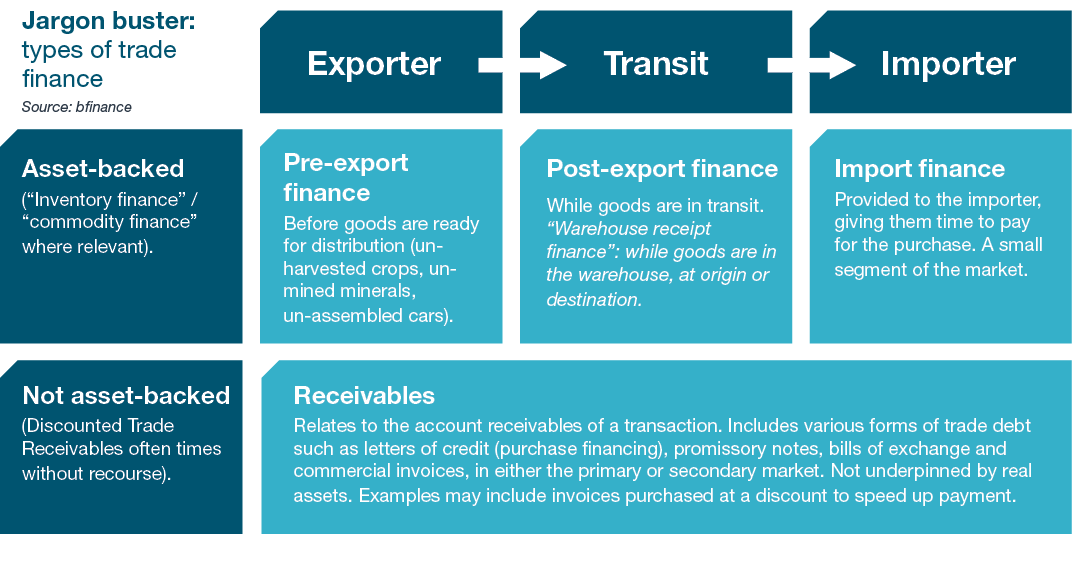bfinance insight from:

Thibault Sandret
Director, Private Markets

Trevor Castledine
Senior Director, Private Markets
Trade Finance remains attractive in today’s ‘even lower for even longer’ climate due to its short-dated, asset-backed, yield-generating profile. Yet 2020 has been an extremely challenging year. Troubles have continued in the third quarter as multiple asset managers moved to close Trade Finance strategies or suspend liquidity for investors and three major banks announced their retreat from the sector. Although this retrenchment may pave the way for attractive opportunities, it is crucial for investors to learn the lessons from recent difficulties and ensure robust implementation.
Commodity and Trade Finance comes in many flavours, ranging from Investment Grade to extremely speculative. The asset class has gained traction in recent years for institutional investors seeking to improve yields versus traditional fixed income without taking on duration risk or sacrificing too much liquidity. The impetus to find investments with this type of profile has never been stronger than it is now, with desperately low yields on today’s short-duration assets. This year, however, is proving to be a seismic test. While some asset managers in this space have performed well, demonstrating resilience in the face of upheaval, others have struggled to stay afloat.

Source: Trade Finance Sector in Brief, bfinance, 2017
Heading for the exits
In August, ABN Amro became the latest bank to announce that it was halting new Trade Finance loans, following the recent retreat by BNP Paribas and Société Générale’s pullback from the Asian market. The impact will be substantial: until recently, more than 90% of Trade Finance globally was serviced by just 15 banks.
On the asset management side, GIB Asset Management decided to close its Trade Finance operations in July, officially attributing this move to “the situation with COVID-19 and its implications for the whole Trade Finance asset class”. A number of other funds have suspended dealing, although these suspensions are intended to be temporary.
While the COVID-19 outbreak has had a massive impact on global trade and commodity markets, not all of the sector’s recent troubles have been directly caused by the pandemic. Another key contributor – explicitly noted in the case of ABN Amro – has been a wave of scandals relating to potentially fraudulent activities from high-profile traders, such as Singapore’s Hin Leong Trading Ltd., although the pandemic has played an indirect role in both exacerbating and unmasking such affairs due to its impact on commodity prices and derivatives positions. Last, but of course not least, the tribulations in the oil market have had a profound impact as well.
Despite the theoretically high level of liquidity supported by short-duration positions, large withdrawals by a dominant fund investor can severely prejudice the remaining investors.
For investors using asset managers to access this asset class, the recent period has highlighted vulnerabilities which can arise from insufficient portfolio diversification (an excessive concentration in a problematic region, sector or a specific borrower) and, in the case of investors using funds, from the actions of fellow investors.
These risks were certainly apparent before the COVID pandemic: the asset class experienced a shock wave in 2018-19 when a couple of asset managers had to unwind some of their Trade Finance funds, essentially driven by an investor withdrawal domino effect (the fund equivalent of a ‘run on the bank’). In the case of the first manager, which focused on South America, a large investor redemption request triggered a liquidity squeeze at the same time as pressures on the Argentinian soymeal sector (to which the fund had heavy exposure) lengthened the average duration of the portfolio; investors became concerned about the viability of the strategy. The reality is that, despite the theoretically high level of liquidity supported by short-duration positions, large withdrawals by a dominant fund investor can severely prejudice the remaining investors. When managers use performing positions to provide the necessary liquidity, the remaining portfolio suffers a significant deterioration in quality. Even though the initial investor withdrawals may not stem from concerns about the portfolio, the result can be a rush for the door as investors seek to avoid being ‘last out’.
These ‘investor runs’, which we have now witnessed again in 2020, can be particularly pronounced in the Trade Finance space as funds tend to have a more concentrated investor base than other private debt strategies and there is a higher level of investor overlap between different funds. While dealing suspensions help to mitigate the fallout for now (at the price of some investor frustration), investors should anticipate longer-term solutions. These are likely to include less generous liquidity provisions, with restrictions on the amount and pace of redemptions, as well as efforts to improve investor diversification within funds.
New attractions
Well-placed institutional investors and asset managers (‘alternative lenders’) will have the opportunity to acquire some high-quality borrower relationships on the back of the current upheaval, and may also be able to obtain higher yields going forward than would have been the case pre-pandemic.
“Do you believe there is a shortage in servicing the Trade Finance needs of the global market?” 346 bankers say:

Source: 2020 ICC Global Survey on Trade Finance
The scope of new opportunities is likely to be considerable: small and medium-sized borrowers or those without investment grade status are likely to be particularly affected by the more constrained climate, but large, highly-rated firms will also be changing and diversifying their bank and non-bank Trade Finance relationships. Some asset managers are distinctly better placed than others to benefit in current conditions, on account of their existing relationships and sourcing channels.
It is important to remember that Trade Finance is an extremely diverse space in terms of risk/reward. While many funds are targeting net returns of 4-6% at moderate risk, investors could also employ a lower-risk strategy in this space by lending to investment grade borrowers or by using various forms of credit enhancement such as insurance. The investment grade space has essentially been dominated by banks and has offered a slim premium over LIBOR net of fees; today’s upheaval, however, may well have a positive impact on supply/demand dynamics for alternative lenders at the lower-risk end of the spectrum. Of the $5.4 trillion global Trade Finance market (annual flows), we estimate that $2-2.5 trillion is likely to be investment grade ($500-600 billion at any given time, presuming an average duration of 90 days). At the other end of the spectrum, we see some managers chasing higher returns by focusing on lower credit quality counterparties and less developed economies. These require significant specialist knowledge and origination capability on the part of the managers and tend to be very capacity-constrained.
Lessons learned for manager selection
For those seeking to invest via asset managers in funds or separate accounts, it is essential that we scrutinise where strategies and structures have come under pressure and ensure a robust approach. It should be noted that it is not essential for investors to use an external asset manager in this asset class: if you are very large and well-resourced it can be possible to partner directly with banks, though we would caution against using just one or two banking relationships, especially in light of accelerated bank retrenchment from the sector.
KEY LESSONS INCLUDE:
1) If you intend to be a significant investor, ensure that you are in an SMA. If your investment is not of sufficient size or expected duration to enable this, ensure that any comingled fund does not have significant concentration to any individual investor (including you). Given the purpose for which many investors use Trade Finance, it is not unusual for funds to experience withdrawal requests or significant deposits: investors need to ensure that their investment will be robust irrespective of other investors’ shifts.
2) It is crucial that the liquidity terms are well-aligned with the investment strategy; potential duration/liquidity mismatches should be anticipated and avoided. Certain strategy types are better suited to lower liquidity provisions. Remember, also, that liquidity is not just about the ability to meet withdrawal requests, but also the ability to deploy new deposits and avoid ‘cash-drag’.
3) Portfolio diversification is key – by geography, by sector and by company. We have seen multiple funds unseated by substantial exposures to problematic obligors. Investors should understand the markets and parts of the supply chain which the manager will be investing in and the risks that are being taken.
4) Investors seeking to make a sizeable commitment to this asset class should strongly consider using multiple managers that access different strata of the market. This approach can be helpful in ensuring full deployment. Take care of overlaps in the investor base, given the sensitivity of these funds to investor withdrawals.
The returns from mainstream Trade Finance, whilst offering what we consider to be enhanced risk/reward, are not so generous as to accomodate any significant level of losses.
5) The manager must be able to demonstrate that they actively monitor all positions for delays in payment and can explain the reasons; there are plenty of legitimate explanations, such as shipping delays, but other reasons can indicate a credit issue or a systematic problem with a particular counterparty.
6) Make sure you understand the accounting approach which the manager will use to value the fund, especially if others may be withdrawing or investing whilst you remain incumbent in the fund. Short duration positions should not suffer significant changes in value and accounting rules (IFRS9) should give investors comfort but the vigour with which these are being implemented needs to be established.
7) Refresh operational and investment due diligence on commitments to Trade Finance on a regular basis, and size positions accordingly. The returns from mainstream Trade Finance, whilst offering what we consider to be enhanced risk/reward, are not so generous as to accommodate any significant level of losses. Where the manager is using credit insurance, investors should scrutinise to ensure that the terms of any insurance are being adhered to by the manager in order that it remains of benefit in the event of a claim.
8) The investor should scrutinise sourcing channels, seeking to avoid managers that depend on a limited number of external players (e.g. banks) to source transactions or are not able to originate their own deals.
The acid tests of 2018 and 2020 will, in the long-term, be immensely helpful in improving the overall health of this asset class. It is now far clearer which types of manager and strategy proved resilient both during the 2018-19 shockwave and the current COVID crisis. More robust approaches to liquidity management, investor diversification, risk management and portfolio diversification are at the forefront of everyone’s minds; careful manager selection is essential. The ‘winners’ of this period will likely go on to benefit from richer pickings.
Important Notices
This commentary is for institutional investors classified as Professional Clients as per FCA handbook rules COBS 3.5R. It does not constitute investment research, a financial promotion or a recommendation of any instrument, strategy or provider. The accuracy of information obtained from third parties has not been independently verified. Opinions not guarantees: the findings and opinions expressed herein are the intellectual property of bfinance and are subject to change; they are not intended to convey any guarantees as to the future performance of the investment products, asset classes, or capital markets discussed. The value of investments can go down as well as up.


 English (Global)
English (Global)  Deutsch (DACH)
Deutsch (DACH)  Italiano (Italia)
Italiano (Italia)  Dutch (Nederlands)
Dutch (Nederlands)  English (United States)
English (United States)  English (Canada)
English (Canada)  French (Canada)
French (Canada) 

